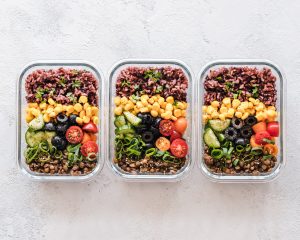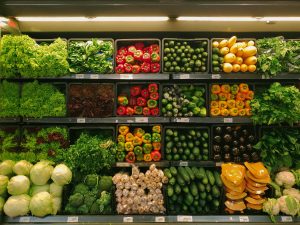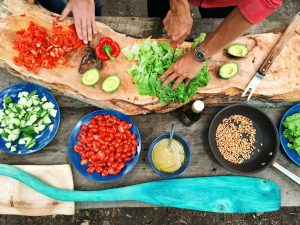How to Meal Prep
Meal prep is the concept of preparing your meals ahead of time to save you time in the future. Most people meal prep one or two days a week. Although it will take up some time, it saves time, energy, and so much thinking, in the long run.
![]()
If you have specific dietary needs, or if you find you don’t have time to cook meals during the week, this is a fantastic way to keep a healthy diet, save money, and save time.
Personally, I like to meal prep on Sundays and Wednesdays. That way, I can keep my meals fresh and I don’t have to eat the same thing all week (which is a common complaint I hear).
LET’S MAKE THIS SIMPLE
You can plan to prep parts of your meals to put together later, or full meals all at once. Personally, I like to do both. I chop some of my vegetables (think greens, potatoes, peppers, and onions) to be used later in easy egg scrambles. Then, I prepare my snacks by separately boxing and bagging foods like carrots, hummus, gluten free pretzels, and trail mix. Lastly, I boil pasta or rice, or roast a squash that I can use with one or multiple meals. Some of these I keep in separate containers, and others I put together to form a meal.
PREPPING TO PREP
I always go into the week with a game plan. This begins with thinking of breakfast, lunches, and dinners and prepping a menu. I like to start with breakfast; my favorites are overnight oats, or egg muffins. I think of the ingredients I need for these, and I add them to my list. Next, I think of what I would like for lunch: usually a big salad with vegetables, protein, and my favorite low-sodium dressing. Lastly, think of a few dinners you may want, and repeat.
An important factor is to consider how many times you eat out during the week. Don’t lie to yourself about this, because you’ll end up wasting food and spending extra money.
Additionally, invest in good cooking equipment, and quality storage containers. I always recommend stainless steel or glass instead of plastic to avoid chemicals leaching into your foods. And great nonstick pans, sharp knives, and a crockpot or slow cooker are always amazing additions to your kitchen.

HEADING TO THE GROCERY STORE
Any grocery store is a great choice, something familiar is always helpful. Personally, I get my produce delivered via Imperfect Foods. I use this service to deliver me discounted food that would have normally been thrown away, which is great for me and for the environment! I do my in person shopping at Trader Joes, Safeway, or H-E-B.

Regardless of if you use a grocery delivery service, go to the grocery store yourself, or do a combination you will need a list. You will probably find that you already have a lot of what you need at home in your pantry, like the staples that you buy in bulk. Be sure to look and see what you already have before making a list and shopping!
When you’ve written your list head to the grocery store to shop for your groceries.
GOING GROCERY SHOPPING
Many people decide on a singular day of the week to meal prep, while others do it twice a week in order to ensure freshness and to decrease food boredom. This totally depends on you, and both options are perfect. It all depends on you, your habits, and your schedule. Even if you prep more than once a week, you can absolutely only go to the store one time if you choose.

Regardless of the option you choose, you should be sure that it is consistent every week. If you choose Sunday and Wednesday, make sure you stick to this so that you consistently have food every day. However, if you find one plan isn’t working for you, try changing it up, there is no wrong way to do this. Also, if you choose the twice a week option, this does not mean you need to shop more than once a week – buy everything in one fell swoop!
When you are at the grocery store, be sure you are looking at the labels. Reading a nutrition label may be new for you, and that is totally fine! Because you may be new to eating a low or controlled sodium diet, what you need to look for is the section that says “Sodium”. Sometimes it is on the front of the package, and other times it is only on the back.
Once you locate the label, find the word “Sodium”, and look at how many milligrams are in each serving. This can be anywhere from 0mg to thousands. A good way to figure out if something is high or low, is to look at the “%DV”, or Percent of Daily Value. Anything higher than 20% is considered high for your daily value in one serving. But, just because something may be high, doesn’t mean you can’t use or purchase the item. Be wary that you can use part of a serving, or combine it with something lower in sodium, to prepare a meal with a normal or lower amount of sodium.
PREPPING YOUR MEALS
Once you finish making your list, checking your cabinets, and grocery shopping, you are ready to start cooking!

You can do the cooking all at once, or in steps, but regardless of how you’re going to do it preparing, portioning, and storing your food is important.
Once you’ve prepared your food, portion and place the meals into containers and reusable snack bags, you are ready for the week!
Maybe you’ve done this for one meal, maybe you’ve done it for all 3. The important thing about meal prepping is consistency, cooking foods you actually like, and adhering to your personal dietary needs. If you need low sodium, don’t add salt, and season your foods with sodium-free seasonings!
Comment below what’s on your menu this week!

